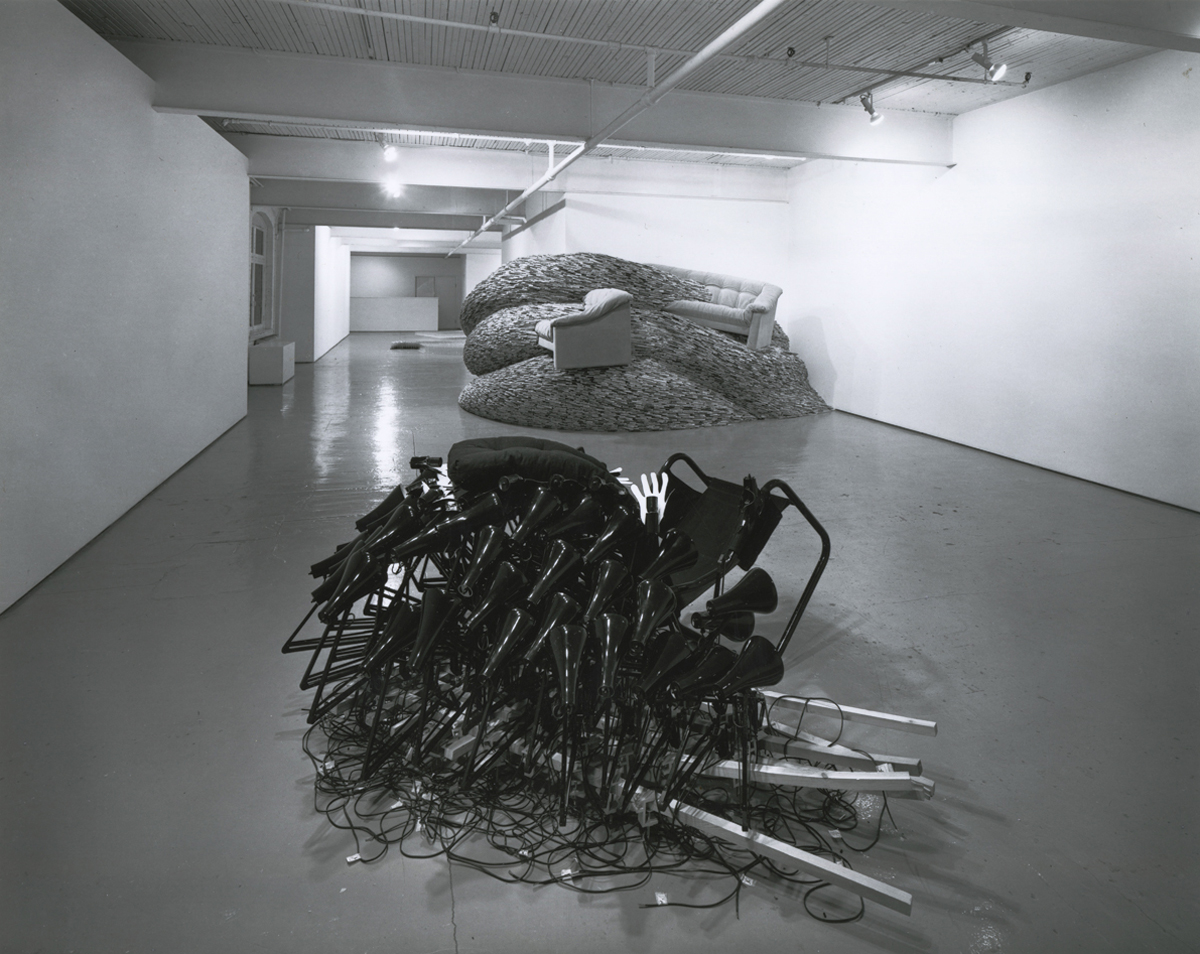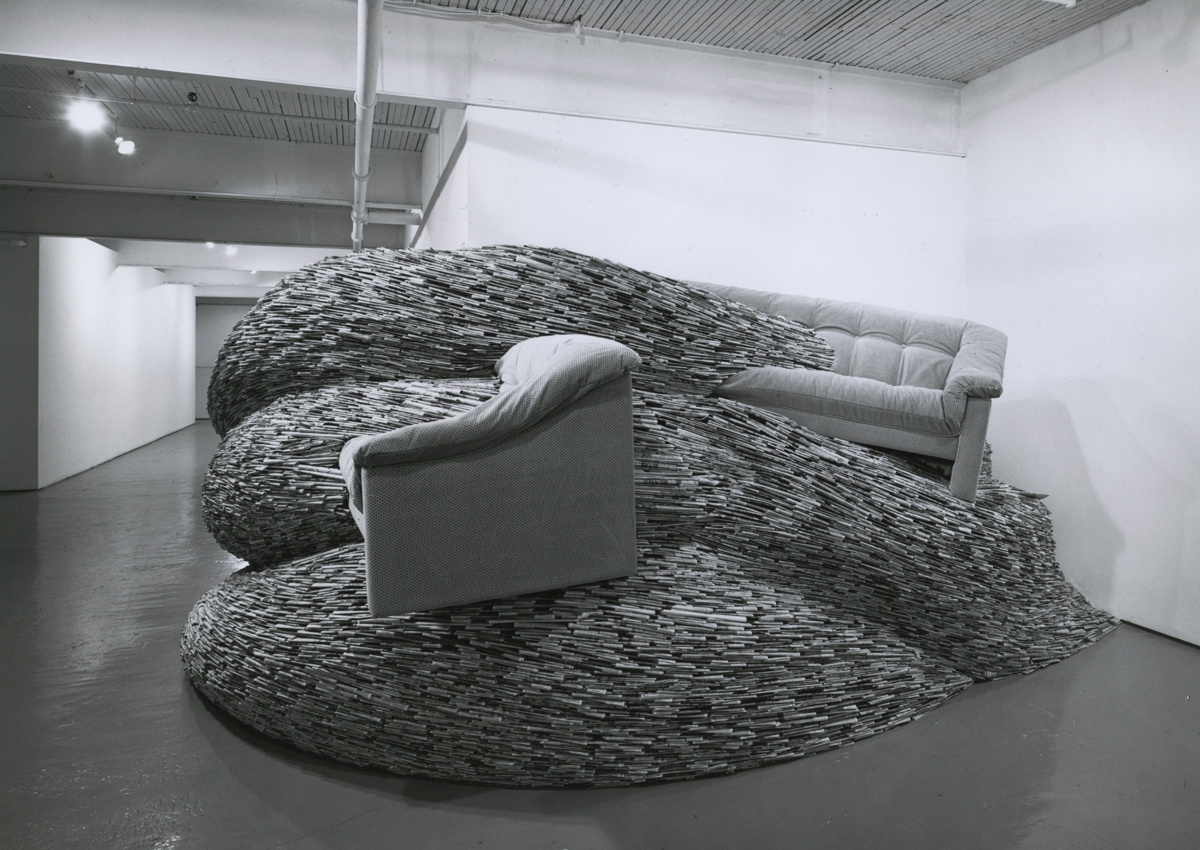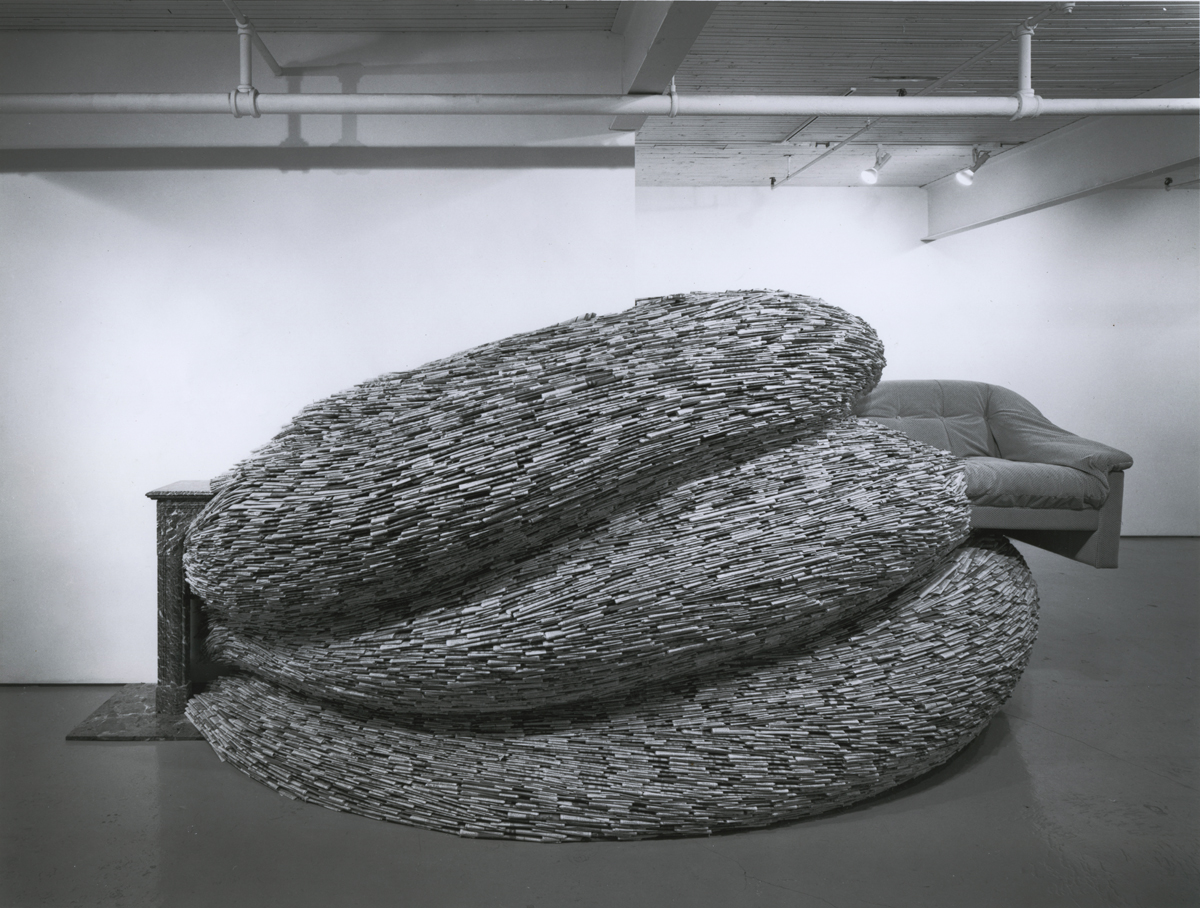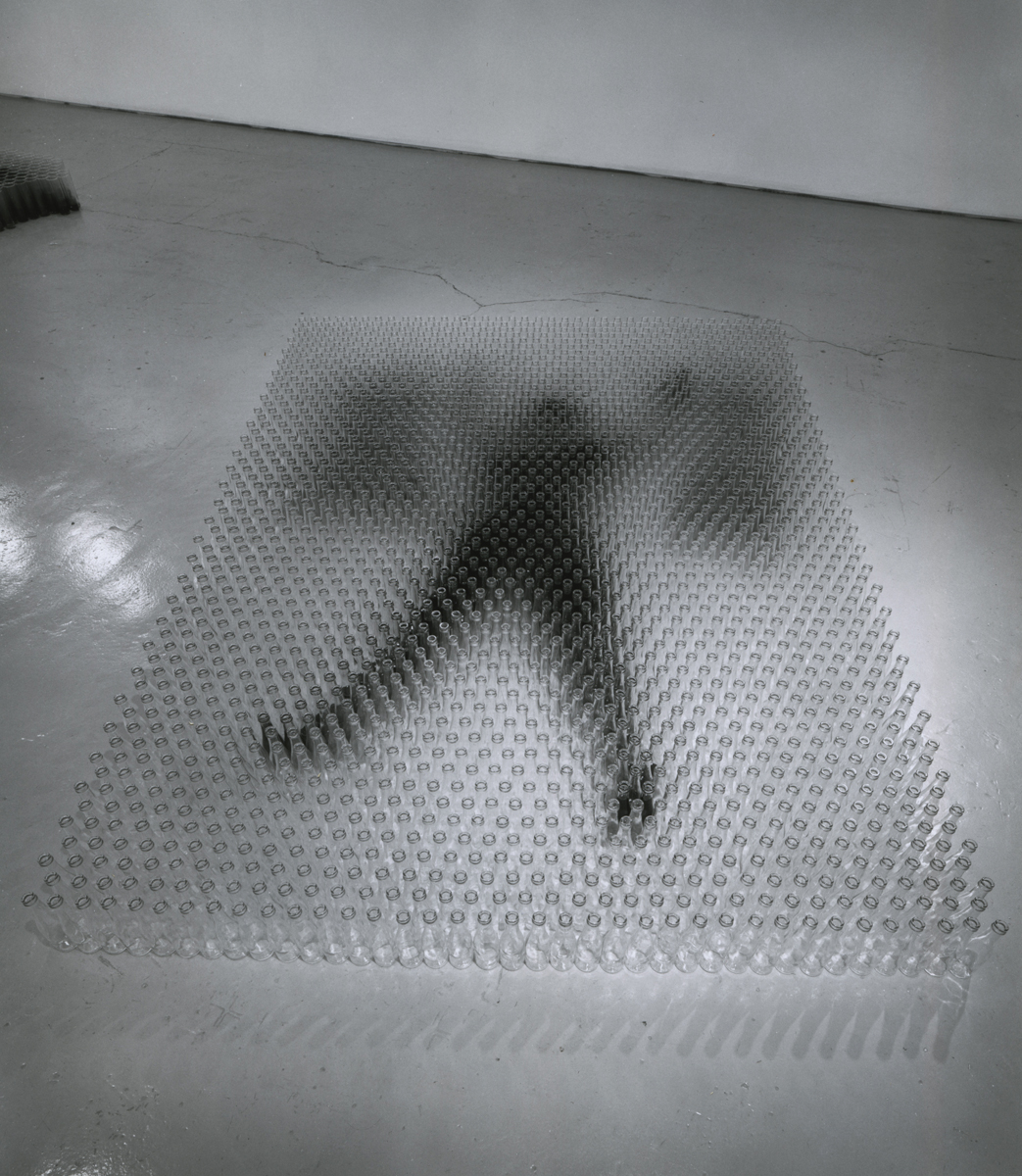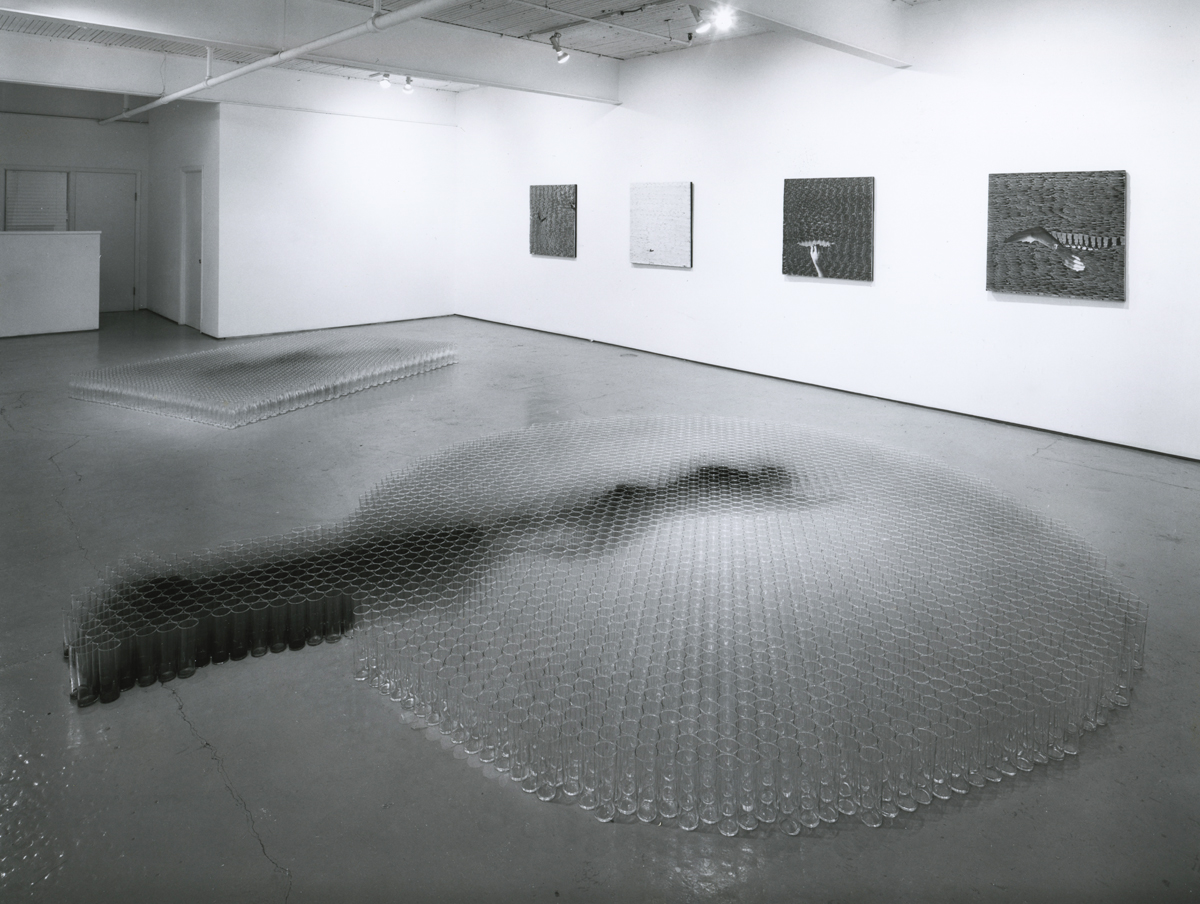East & West Galleries:
A solo exhibition of sculpture and drawings by British artist David Mach will open at Mercer Union on April 10, 1986. While in Toronto, David Mach will create several site-related sculptures in both exhibition spaces, incorporating imported and locally manufactured materials. The materials are high profile objects in themselves and are used in multiples to create an image or form. Concerned with mass production and the mindless repetition of such production, the materials employed by Mach serve to comment on, and satirize the loss of individuality in our contemporary consumer society.
Four sculptures and four drawings will be featured in this exhibition. Locally manufactured beer bottles and glasses, magazines, domestic furnishings, and imported desk lamps will be arranged into sculpture installations. The drawings will be composed from Toronto postcards and playing cards.
David Mach
Mercer Union
Toronto
April 10 to May 3
Randy Anderson
Alan Storey
Mercer Union
Toronto
June 10 to July 5
Gary Michael Dault
Vanguard, September 1986
Like his fellow Englishman Tony Cragg, sculptor David Mach makes work that is the product of accumulation, of elements in aggregate. Also like Cragg, he builds up his pieces from materials available at the time and near the site, typically unlovely everyday items that are cheaply acquired and which possess basic generalized looks.
For his exhibition Mach showed four major sculptures and a number of collages. The collages were the product of Mach's cutting up hundreds of postcards of the same view (banal images of Toronto and environs) and assembling the overlapping shards into stuttering stop-motion fields which swallowed up the tiny protagonists projected into the heaving, sliding grounds - a persuasive metaphor for the engulfing of the individual within a culture that has be come a torrential flow of characterless objects and indigestible amounts of information.
The sculptures make the abstract commentary of the collages more explicit and more personal. Unlike Cragg, who finds what he needs in the streets, Mach's materials are store-bought in quantity. His Getting Comfortable, for example, is comprised of a chair onto which have been clamped a clamouring horde of brand-new black desk-lamps, some of them cut to resemble hands. Here, as in the collages, there is a stop-action feel to the piece, as if the lamps were the blur caused by one lamp in the animated process of adjustment. At the same time, there is the feeling that one lamp won't do, that the piece is a fast-forwarding of consumerism, that getting comfortable (which appears to be a scary and futile process in Mach's hands) is the product of the numbing, restless commodification of desire, where, as Emerson once complained, "things are in the saddle and ride mankind."
As richly successful in its poetic questioning of the validity of the structures upon which contemporary culture has erected its various orders of compliance and of self-congratulation, was the ambitious untitled work illustrated here. Built around a projecting inside corner of the gallery, the work was erected on a central armature of collected newspapers (thousands of copies of the Toronto Star) carefully arranged into three massive, billowy forms that looked like puffs of stop-action smoke. These puffs seem to be emanating from or be sucking towards a green marble fireplace placed flat against the wall. Caught up in the billows, like Dorothy's house caught up in the Kansas twister, were two standard issue sofas (beige, like the newspapers). A perfect complement to Getting Comfortable, this frozen whirlwind of repetitive information and artifactuality has provided what ever buoyancy these bourgeois sofas (and presumably their imagined inhabitants) receive. Here, at the still point of a turning world, repetition as information is the calming heart beat of the consumerist life. The work as a whole is a consummately banal ascension, an apotheosis of the quantitative.
It was William Carlos Williams who said "no ideas but in things." Things, in their benign and demonic modes, informed yet another exhibition at Mercer Union as well: curator Daina Augaitis's Objecthood: A Dichotomy. Augaitis's show was a dual presentation of installations by Randy Anderson and Alan Storey, each of whom contributed a cluster of ideas to the ongoing debate about the status of the object in contemporary art and the degree to which the art object is informed by (or informs) the social structure out of which it comes.
Anderson, proceeding on the assumption that consumable art objects feed to the point of surfeit and political indigestion the gluttonous market economy to which the bedrock art audience is a sidebar, designs configurations for the gallery wall, cut from his own designer commodity "wallpaper." Anderson's silk-screened wallpaper, from which he cuts out his messages, is made up of stylized representations of an array of consumable objects - a blue kettle, a yellow telephone, a grey toilet (lid up), a green TV, red and white automobiles - on grounds that vary from red to grey to black or white. Anderson's use of this wall paper as a medium is sometimes ingenious and sometimes flatfooted. A gigantic wallpaper replica of his own signature, for example, tells us rather too bluntly that it is the artist's signature that has too often been the magic conjuration of the things that spell material success. More interesting was his wall-sized wallpaper portrait of Duchamp's bicycle Wheel (1913) - the anti-art anti-commodity poignantly transformed by history into a supercommodity all its own.
As an inversion of Anderson's role as commodity-bater in Objecthood: A Dichotomy, Alan Storey celebrated the object on an epic scale, having designed and built a wonderfully touching and endearingly ineffectual machine, laboriously crafted from heavy timbers and ingeniously rigged up with weights and pulleys and a motor - a machine whose sole purpose it seems to be to ink a horizontally-positioned "nib" of a bicycle wheel and then propel this inked wheel onerously (and yet delicately) around the perimeter of the gallery, leaving behind draggy intermittent "sensitively drawn" lines. Storey is a virtuoso of bathos. This dinosaur of a machine, this structural white elephant, is so ponderously inefficient it is both a sentimental tribute and farewell to mechanization itself and an emblem of despair at the entire idea of making marks of virtue on gallery walls. Here delicacy of line is the product of the drawing-machine's absurd over-specialization. Alan Storey's Draw (cf. Merike Talve's review of the Vancouver installation, Vanguard, February 1985) is brilliant compression of the bureaucratization of art, the bureaucratization even of expressiveness itself. Looking at Draw, we laugh, as Byron said, so that we may not weep.
Turning Waste into Ingenious sculpture
Carole Corbeil
Globe and Mail, April 1986
David Mach, sculpture at Mercer Union.
British sculptor David Mach works with waste with the refuse of conspicuous consumption. He has crafted a Polaris submarine from old car tires, a Rolls-Royce from 15,000 books, and in his first Toronto show, be has used locally manufactured stuff for his sculptural installations, as well as Toronto post cards for five multilevel "drawings."
What is immediately astounding about Mach's work is his virtuosity with unexpected materials. Take his use of 2 1/2 tons of Toronto Star newspapers. They have been folded and piled in such a way as to make a huge mass of curvilinear waves, in which two couches are partially buried. The papers actually begin their journey from the inside of a marble fire place and then around a corner of the gallery. They are bound together only by their own weight. The mass has a wonderfully sensuous form, and, from afar, a lovely fine-art texture; the contrast between this form and its substance is stunning.
Ingenuity, rather than virtuosity, comes into play in Mach's use of clear glasses and bottles The glasses are on the floor, grouped together to form what looks like a child's version of a tree, with the figure of a man leaping up. The colour differentiation, the drawing of the figure is achieved by filling the glasses with various levels of what looks like purple soda pop. In the bottles, Mach has used red soda pop, and has assembled the bottles in such a way that you can read an exact figure of a woman with two red scarves on either side. The red and the composition recall the Canadian flag.
Mach's "drawings" are made up of Toronto postcards which have been piled on top of one another like a three-dimensional photomontage, there is a lovely trompe l'oeil effect with some postcards of Casa Loma - from a distance, a hand looks like it has created Niagara Falls, or ripped a hole in the earth. In another, a submarine cruises Lake Ontario while a family cruises in a pleasure boat. On the local level, Mach seems to have picked up on the false, clean benignity of Toronto.
While Mach may be involved in a political critique of the grotesque waste of industrialized nations, he does so with such imaginative pleasure that he turns the world into a playground. The appetite we recognize here is the child's appetite for substitution, for taking one thing and using it in such a way that it loses its original, functional meaning. His work suggests that just as there is an ecology of use, there is such a thing as an ecology of play.
DAVID MACH, Mercer Union
Jane Purdue
Now Magazine, April 1986
British artist David Mach has, at 30, established quite a reputation for himself in England and Europe --a reputation likely to be enhanced through his current Mercer Union show opening tonight (Thursday, April 10). It began in 1979, when a Welsh book dealer donated 15,000 volumes of second hand books, enabling Mach to assemble them into a facsimile of a Rolls Royce. (The books were being sold by the carload and hence, the visual pun.)
Since then, Mach has completed several other gigantic sculptures in the form of a Centurion tank, a train, some submarines and a Volkswagen beetle made from stacks of German telephone directories. In preparation for the Toronto show, Mach has been in the city for a few weeks collecting his materials. Hundreds of locally manufactured beer bottles, furnishings, magazines, some 500 desk lamps, playing cards and postcards from Toronto will be in corporated into four site-related sculptures and drawings.
"Entertainment is a very serious thing that has to work," says Mach, and through his humour he draws attention to the overproduction of our consumer society. His massive installations (both indoors and out) have attracted serious attention recently. His solo exhibition at the notable Museum of Modem Art Oxford was well received and he has just opened at the Barbara Toll Gallery in New York.
Mach maintains that because people can recognize the industrial products, his art is more readily accepted. "I actually believe that the materials break down the barriers, break down the stigmas of art."
